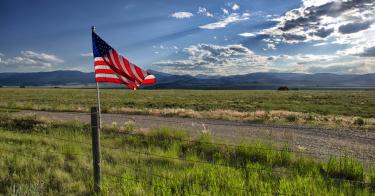The federal government owns 1.1 percent of Illinois today. That’s a pittance compared to Washington’s holdings in the American West.
But there was a time when “the West” lay between the Appalachian Mountains and the Mississippi River, and federal land ownership was a major concern in Illinois.
In 1829, the federal government owned 95 percent of the state.
Imagine how different Illinois would be today if the decision-making power for 95 percent of Illinois had remained with the 535 members of Congress and the Interior Department rather than with the people of Illinois and their elected officials.
Matters normally left to local governments and zoning boards, such as energy and water infrastructure, roads, new construction, even property taxes and the means to fund local schools, fire and rescue, would need to be handled through federal legislation or resource management plans open first for public comment from anyone — from Californians and Mainers, to national corporations and special interest groups.
That’s exactly what the members of the Illinois General Assembly feared in 1829. Seeing federal ownership as “no less than the deprivation of some of the essential attributes of its sovereignty,” they petitioned Congress for reprieve from federal ownership and land prices that all but prohibited transfer. Without reprieve, they wrote, “It will be hundreds of years before the soil will have passed out of the control of the general government,” a situation constituents already considered “injurious” and “proving highly detrimental to the State.”
There was a time when Congress enthusiastically used its Constitutional power to transfer lands. Congress sold and transferred thousands of acres to states, schools, railroads, veterans, farmers and ranchers, homesteaders, and even such interesting types as “French emigrants to cultivate the vine and olive.” The congressional debate wasn’t over whether to divest of federal lands. The major questions were only: to whom should the land be ceded; how should it be turned over, and what should be done with the revenue? (Initially, revenue from the sale of federal lands completely paid off Revolutionary War debts.)
It was a good time for Illinois to be considered the West and divestment of lands was a tremendous boon to the state’s development. But the imagined future of Illinois mentioned above is reality for some states today.
The federal government still owns roughly 640 million acres. Contrary to popular perception, only 80 million acres are national parks (all 419 of them).
Only 7 percent of the federal holdings lie east of the Rockies. The rest is in just 12 western states. In fact, Washington owns more than half of the land in five states: Oregon (53 percent), Alaska (61 percent), Idaho (62 percent), Utah (63 percent), and Nevada (80 percent).
And that’s not everything in Washington’s real estate portfolio. The feds own another 700 million acres underground and 1.7 billion acres off America’s coasts.
Management of these massive and diverse lands is disjointed, being spread across four agencies governed by a complex of overlapping and often conflicting laws, missions and regulations. Different presidential administrations have interpreted and implemented these laws in drastically different ways to either encourage access to federal lands or heavily restrict their use. The results often aren’t good.
The federal government routinely loses value and money on its lands — losses that are covered by taxpayers, whether they live in Utah or Illinois. According to the Property and Environmental Research Center, the Forest Service and Bureau of Land Management lost $4.38 per acre from 2009–2013, while trust lands in four western states earned $34.60 per acre.
The National Park Service alone has $11.6 billion in deferred maintenance and another $2.6 billion in “critical or serious deferred maintenance,” including building repair, water and wastewater systems and trails. And while fewer fires start on federal land, they cause more damaged acreage for lack of actively managing forests. This cost taxpayers a record $3 billion in 2018.
Washington-centric approaches to management stifle creative solutions to competing interests that could be resolved at local, state, or regional levels without the added baggage of national politics. Further, overly broad, unclear, or outdated environmental laws invite litigation, incentivizing bureaucrats to divert resources from actual land management activities as they analyze, delay, or avoid action at all.
In contrast, states can utilize local creativity and accountability for better stewardship. Consider the American buffalo. Near extinction a century ago, the buffalo’s recovery is due almost entirely to innovative, market-driven policies implemented on state and private lands.
South Dakota’s Custer State Park offers one example of creative management with its popular annual buffalo roundups and auctions. This keeps herds healthy, creates opportunities to educate the public, and generates revenue that goes back into improving the park.
In contrast, Yellowstone National Park donates or hunts excess buffalo. This costs taxpayers more than $1 million annually, but it’s easier than navigating federal regulations. Today, 90 percent of the buffalo population resides on private and state lands.
While not perfect, private and state management of lands has proved successful. Unsurprisingly so, given that residents have powerful incentives to be good stewards of the land around them. More state and private management of currently federal lands would put these assets and responsibilities in the hands of people who have an immediate stake in wise management.
It would also give local communities greater say in decisions that directly impact their livelihoods. As it has elsewhere, this could allow for creative compromises between varied and sometimes competing interests to better reflect the unique circumstances, histories, and priorities of states. America would benefit from the innovation and experimentation in state policies.
Disposition of federal lands was good for Illinois. Why can’t it also be done for the new American West?
This piece originally appeared in the Illinois Business Journal



